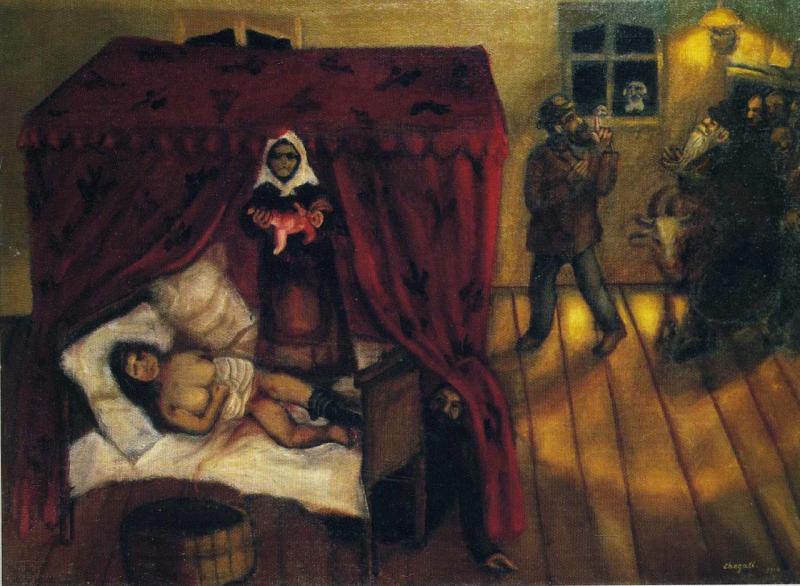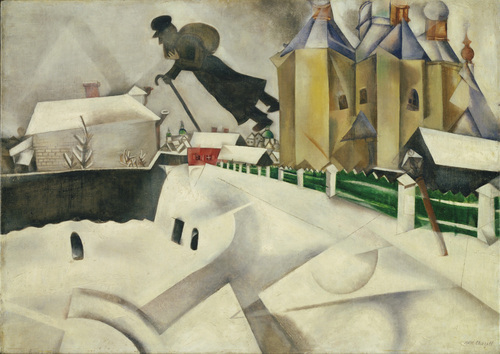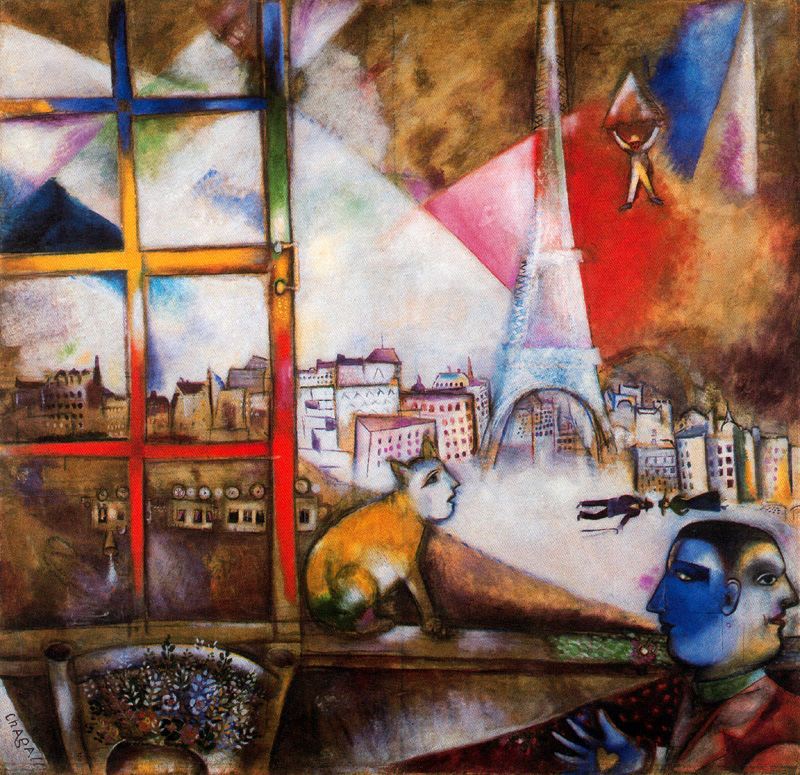Chagall: Modern Master, Tate Liverpool | reviews, news & interviews
Chagall: Modern Master, Tate Liverpool
Chagall: Modern Master, Tate Liverpool
Sugar-coated sentimentality is a default tendency with this Russian modernist, but the charm still wins through

“Charming” is undoubtedly a double-edged word. Along with its perfumed allure, it carries a whiff of insincerity, of something slick and not quite earned. Add “whimsical” and you know you’re in danger of saccharine overload. Chagall is both, plus he’s one of the most popular artists of the 20th century. Does it get any worse?
Marc Chagall was born Moyshe Shagal in Vitebsk, a region now in modern-day Belarus with a big Hassidic population. And though he absorbed some of the ideas of Cubism during his three years in Paris as a young man, his paintings are infused with the mystical and the folklorish, in tender homage to his Russian Jewish background: paintings like The Violinist, 1911-14, in which an old Jewish fiddler appears, shaggy-bearded and green-faced, as one of his stock characters, and Over Vitebsk, 1922 (pictured below), in which one of his wandering Jewish peddlers floats above a snow-covered shtetl with a sack slung over his back.
Stage sets are where Chagall excelled as an artist
The exhibition, the first survey in the UK for 15 years ago, focuses on the years between 1911 to 1922, the period of his most intense creativity, though there is one earlier work, Birth, of 1910 (main picture), painted a year before he left for Paris, aged 23. Reminiscent of a crude Mexican votive painting, the dimly lit scene depicts a mother lying naked and exhausted on blood-soiled sheets, having just given birth. A grim-faced midwife holds the bloodied newborn, while the father cowers under the bed, partly hidden by the puce-coloured curtains pulled back as if opening onto a stage set. Pushing through the door and peeping through the window, which looks out onto a black night, are the villagers, accompanied by an ox, and a rabbi. Raw tenderness and slapstick comedy in one scene.
 In fact, stage sets are where Chagall excelled as an artist. He trained under the great set and costume designer Leon Bakst, who worked with Diaghilev’s Ballets Russes, creating bold designs for Stravinsky’s avant-garde music and Fokine’s daring choreography, and it was to work for Diaghilev that Chagall left for Paris in 1911. It was also during this period when he was exposed to Cubism and the Orphism of his friend Robert Delaunay, who infused his fractured forms with soft, expressive colours. He took all this on board not so much as an intellectual investigation of space and form, but as a stylistic device, creating pastoral poetry with his dream-like scenes of floating lovers, boneless figures elegently swaying and bending any which way and creatures with sphinx-like, wisely benign faces.
In fact, stage sets are where Chagall excelled as an artist. He trained under the great set and costume designer Leon Bakst, who worked with Diaghilev’s Ballets Russes, creating bold designs for Stravinsky’s avant-garde music and Fokine’s daring choreography, and it was to work for Diaghilev that Chagall left for Paris in 1911. It was also during this period when he was exposed to Cubism and the Orphism of his friend Robert Delaunay, who infused his fractured forms with soft, expressive colours. He took all this on board not so much as an intellectual investigation of space and form, but as a stylistic device, creating pastoral poetry with his dream-like scenes of floating lovers, boneless figures elegently swaying and bending any which way and creatures with sphinx-like, wisely benign faces.
The centrepiece of the exhibition are the murals Chagall created in 1920 for the Moscow theatre impresario Alexander Granovsky. Five upright panels for the Russian State Jewish Chamber Theatre depict archetypal Jewish characters: the violinist, the marriage broker, the wedding dancer, the Torah scholar and the wedding jester. There is also the eight-metre-long epic The Wedding Feast in which acrobats and musicians, as well as goats and hens, parade across a dynamic rainbow-coloured backdrop of arcing and diagonal forms.
Having found himself stranded in Russia, first by the outbreak of war, then by the Revolution, Chagall flirted briefly with the geometric abstraction favoured by the new Soviet regime, but although his efforts were always uniquely rooted in his Jewish background – one abstract collage has a cut-out with Hebrew lettering printed across it – his heart was clearly never in it. He’d also been appointed commissar of the Vitebsk art school, which had also recruited Malevich and El Lissitzky, though here Chagall found himself so at odds with the prevailing theories of the Soviet avant-garde that he soon resigned his post.
 Two of Chagall’s best-loved works, Paris Through the Window, 1913 (pictured left), from the Guggenheim in New York, and The Promenade, 1917-18, from the State Russian Museum in St Petersburg, are here. The first features that soaring icon of modernity, the Eiffel Tower, glittering against a vista of blushing pinks and sunny yellows, while a nonchalant human-faced cat stares up at a parachuting figure in the sky. The second shows two lovers, a self-portrait with the artist's future wife Bella - in which Chagall presents himself as a hearty, beaming fellow solidly anchored by gravity, while Bella floats above him like a billowing kite, her hand firmly clasping his. The village spreads out around them like a lustrous miniature toy town.
Two of Chagall’s best-loved works, Paris Through the Window, 1913 (pictured left), from the Guggenheim in New York, and The Promenade, 1917-18, from the State Russian Museum in St Petersburg, are here. The first features that soaring icon of modernity, the Eiffel Tower, glittering against a vista of blushing pinks and sunny yellows, while a nonchalant human-faced cat stares up at a parachuting figure in the sky. The second shows two lovers, a self-portrait with the artist's future wife Bella - in which Chagall presents himself as a hearty, beaming fellow solidly anchored by gravity, while Bella floats above him like a billowing kite, her hand firmly clasping his. The village spreads out around them like a lustrous miniature toy town.
Chagall’s sugar-coated sentimentality is a default tendency, and when he moves away from it, for instance in the glowering Jew in Red, 1915, it feels just a little forced. His later works, post-1922, of which we get a only a small taste, shows that he’d already achieved his most powerful compositions in those short years in Paris and then in the few years just before and after the Russian Revolution. The exhibition ends with Mauve Nude, 1967. This might lack something of the simplicity and directness of the earlier work, but the colours still sing out.
Share this article
The future of Arts Journalism
You can stop theartsdesk.com closing!
We urgently need financing to survive. Our fundraising drive has thus far raised £49,000 but we need to reach £100,000 or we will be forced to close. Please contribute here: https://gofund.me/c3f6033d
And if you can forward this information to anyone who might assist, we’d be grateful.

Subscribe to theartsdesk.com
Thank you for continuing to read our work on theartsdesk.com. For unlimited access to every article in its entirety, including our archive of more than 15,000 pieces, we're asking for £5 per month or £40 per year. We feel it's a very good deal, and hope you do too.
To take a subscription now simply click here.
And if you're looking for that extra gift for a friend or family member, why not treat them to a theartsdesk.com gift subscription?
more Visual arts
 'We are bowled over!' Thank you for your messages of love and support
Much-appreciated words of commendation from readers and the cultural community
'We are bowled over!' Thank you for your messages of love and support
Much-appreciated words of commendation from readers and the cultural community
![SEX MONEY RACE RELIGION [2016] by Gilbert and George. Installation shot of Gilbert & George 21ST CENTURY PICTURES Hayward Gallery](https://theartsdesk.com/sites/default/files/styles/thumbnail/public/mastimages/Gilbert%20%26%20George_%2021ST%20CENTURY%20PICTURES.%20SEX%20MONEY%20RACE%20RELIGION%20%5B2016%5D.%20Photo_%20Mark%20Blower.%20Courtesy%20of%20the%20Gilbert%20%26%20George%20and%20the%20Hayward%20Gallery._0.jpg?itok=7tVsLyR-) Gilbert & George, 21st Century Pictures, Hayward Gallery review - brash, bright and not so beautiful
The couple's coloured photomontages shout louder than ever, causing sensory overload
Gilbert & George, 21st Century Pictures, Hayward Gallery review - brash, bright and not so beautiful
The couple's coloured photomontages shout louder than ever, causing sensory overload
 Lee Miller, Tate Britain review - an extraordinary career that remains an enigma
Fashion photographer, artist or war reporter; will the real Lee Miller please step forward?
Lee Miller, Tate Britain review - an extraordinary career that remains an enigma
Fashion photographer, artist or war reporter; will the real Lee Miller please step forward?
 Kerry James Marshall: The Histories, Royal Academy review - a triumphant celebration of blackness
Room after room of glorious paintings
Kerry James Marshall: The Histories, Royal Academy review - a triumphant celebration of blackness
Room after room of glorious paintings
 Folkestone Triennial 2025 - landscape, seascape, art lovers' escape
Locally rooted festival brings home many but not all global concerns
Folkestone Triennial 2025 - landscape, seascape, art lovers' escape
Locally rooted festival brings home many but not all global concerns
 Sir Brian Clarke (1953-2025) - a personal tribute
Remembering an artist with a gift for the transcendent
Sir Brian Clarke (1953-2025) - a personal tribute
Remembering an artist with a gift for the transcendent
 Emily Kam Kngwarray, Tate Modern review - glimpses of another world
Pictures that are an affirmation of belonging
Emily Kam Kngwarray, Tate Modern review - glimpses of another world
Pictures that are an affirmation of belonging
 Kiefer / Van Gogh, Royal Academy review - a pairing of opposites
Small scale intensity meets large scale melodrama
Kiefer / Van Gogh, Royal Academy review - a pairing of opposites
Small scale intensity meets large scale melodrama
 Jenny Saville: The Anatomy of Painting, National Portrait Gallery review - a protégé losing her way
A brilliant painter in search of a worthwhile subject
Jenny Saville: The Anatomy of Painting, National Portrait Gallery review - a protégé losing her way
A brilliant painter in search of a worthwhile subject
 Abstract Erotic, Courtauld Gallery review - sculpture that is sensuous, funny and subversive
Testing the boundaries of good taste, and winning
Abstract Erotic, Courtauld Gallery review - sculpture that is sensuous, funny and subversive
Testing the boundaries of good taste, and winning
 Edward Burra, Tate Britain review - watercolour made mainstream
Social satire with a nasty bite
Edward Burra, Tate Britain review - watercolour made mainstream
Social satire with a nasty bite
 Ithell Colquhoun, Tate Britain review - revelations of a weird and wonderful world
Emanations from the unconscious
Ithell Colquhoun, Tate Britain review - revelations of a weird and wonderful world
Emanations from the unconscious

Add comment